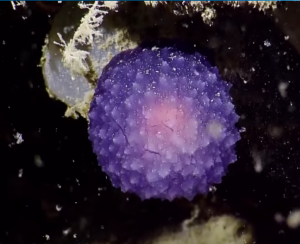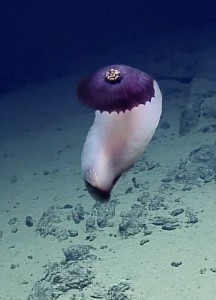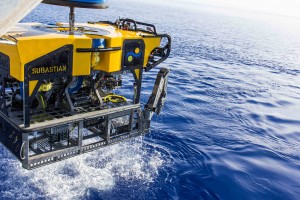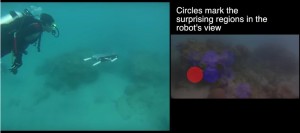Nat’l Ocean Exploration Forum – New York
19 Oct 2016

Mysterious purple orb — likened to a disco ball — may prove to be a new-to-science ocean animal. Photo: http://bit.ly/2dBQDoC Video: http://bit.ly/2cXM5Ho Credit: Ocean Exploration Trust
-
Portable observatories and new marine vehicles: The hinge of historic change in deep sea exploration
-
Yet to be found worldwide: A million species, a million wrecks in “world’s largest museum”
-
Transformative new technologies opening “citizen science era of ocean exploration”
-
100 experts convene for national Forum: Beyond the Ships, Marine Exploration, 2020-2025
-
Little known of “submerged America” – the half of US territory that lies under the sea
-
Complete mapping of “Gurgle Earth” achievable
-
Year of purple sea creatures celebrated with disco ball orb, vampire squid
Five hundred vents newly discovered off the US West Coast, each bubbling methane from Earth’s belly, top a long list of revelations about “submerged America” being celebrated by leading marine explorers meeting in New York.
“It appears that the entire coast off Washington, Oregon and California is a giant methane seep,” says RMS Titanic discoverer Robert Ballard, who found the new-to-science vents on summer expeditions by his ship, Nautilus.
The discoveries double to about 1,000 the number of such vents now known to exist along the continental margins of the USA. This fizzing methane (video: http://bit.
“This is an area ripe for discovery,” says Dr. Nicole Raineault, Director of Science Operations with Dr. Ballard’s Ocean Exploration Trust. “We do not know how many seeps exist, even in US waters, how long they have been active, how persistent they are, what activated them or how much methane, if any, makes it into the atmosphere.”
Further research and measuring will help fill important knowledge gaps, including how hydrocarbons behave at depth underwater and within the geological structure of the ocean floor.
Expeditions this year include also NOAA’s Deepwater Exploration of the Marianas Trench – a 59-day voyage with 22 dives into the planet’s deepest known canyons in the Pacific Ocean near Guam.
NOAA explorers added three new hydrothermal vents to the world’s inventory and a new high-temperature “black smoker” vent field composed of chimneys up to 30 meters tall – the height of a nine-story building.
Also revealed: a tiny spot volcano (the first ever discovered in US waters), a new mud volcano, thick gardens of deep-sea corals and sponges, a rare high-density community of basket stars and crinoids (a living fossil), and historic wreckage from World War II. (Photo, video log: http://bit.
Bizarre purple animals
Scores of spectacular, rare and sometimes baffling unknown species encountered on this year’s first-ever voyages to new deep ocean areas include several purple animals such as:
- A bizarre purple “mud monster”: the “acorn worm.” Photo: http://bit.
ly/ 2dytSnW, video: http://bit. ly/ 2d6FQ6a,
credit: NOAA -

Purple sea cucumber, reminiscent of a flying Mary Poppins, found on NOAA’s Deepwater Exploration of the planet’s deepest known canyons, in the Pacific Ocean near Guam. Photo: http://bit.ly/2dQdURC,
video: http://bit.ly/2d6FQ6a, credit: NOAASwimming purple sea cucumber, reminiscent of a flying Mary Poppins. Photo: http://bit.
ly/ 2dQdURC, video: http://bit. ly/ 2d6FQ6a,
credit: NOAA - A mysterious purple orb, likened by one scientist to a disco ball, that may prove to be new to science. Photo: http://bit.
ly/ 2dBQDoC, video: http://bit. ly/ 2cXM5Ho,
credit: Ocean Exploration Trust - A rare purple Vampire Squid, (Vampyroteuthis infernalis), a deep-sea creature nicknamed for its deep color and red eyes (not because it feeds on blood). Photo: http://bit.
ly/ 2dlk2mo video: http://bit. ly/ 2ctAimv,
credit: Ocean Exploration Trust - Stubby “googly-eyed” purple animal looking like a cross between an octopus and a squid. Photo: http://bit.
ly/ 2d8UWHn, video: http://bit. ly/ 2cYoQ13
Credit: Ocean Exploration Trust
Beyond being spectacularly photogenic, such animals help scientists better understand the web of life that sustains all species, including humans.
As well, understanding how “extremophile” lifeforms survive in such conditions (piezophiles, for example, thrive in high pressure; pyschrophiles, aka cryophiles, live in water as cold as ?20 °C, as in pockets of very salty brine surrounded by sea ice), is usefully relevant to food and pharmaceutical preservation technologies, medical technology, nanotechnology and energy science.
Ocean exploration undergoing historic transformation
Dr. Ballard and about 100 other leading figures in marine science meet Oct. 20-21 to compare thoughts on the future of marine exploration at the 2016 National Ocean Exploration Forum, “Beyond the Ships: 2020-2025,” hosted in New York by The Rockefeller University in partnership with Monmouth University. The Forum is also supported by the Monmouth-Rockefeller Marine Science and Policy Initiative, NOAA, the Schmidt Ocean Institute, and James A. Austin, Jr.
Ocean exploration has arrived at a historic hinge, Forum organizers say, with profound transformation underway thanks to new technologies, led by increasingly affordable “roboats” – autonomous or remotely controlled vehicles that dive into the ocean or ply the surface laden with sensors collecting information from instruments suspended beneath them.

ROV SuBastian, a new eco-friendly 3,100 kg (6,500 pound) deep-sea research platform for the Schmidt Ocean Institute’s R/V Falkor, equipped with ultra high-resolution 4K cameras, mechanical arms that move seven ways and can sample to depths of 4,500 meters (2.8 miles), with a lighting system equivalent to the lamps of 150 car high-beams.
Credit: Schmidt Ocean Institute
ROV SuBastian, for example, is a new eco-friendly 3,100 kg (6,500 pound) deep-sea research platform for the Schmidt Ocean Institute’s R/V Falkor, equipped with ultra high-resolution 4K cameras, mechanical arms that move seven ways and can sample to depths of 4,500 meters (2.8 miles), with a lighting system equivalent to the lamps of 150 car high-beams. (SuBastian sea trials video: http://bit.
Says Wendy Schmidt, co-founder of Schmidt Ocean Institute: “With ROV SuBastian we will help make life on the ocean floor real to people who will never visit the sea, so they, too, can begin to appreciate the importance of ocean health and make the connection between life in the deep sea and life on land.”
“You don’t have to be a scientist at sea to recognize the importance of the marine environment, and we are only at the beginning of our understanding. We never anticipated discovering the world’s deepest living fish, the ghostfish (video: http://bit.
ROV SuBastian will have that opportunity this December during its first science cruise, in the Mariana Back-Arc in the western Pacific. (Cruise details: http://bit.
Contributing as well to the transformation: Modern communications and sampling techniques, including eDNA, big data analysis and other high-tech advances that automate and vastly accelerate the work, opening the way for experts and the public to reach, see, chart, sample and monitor formerly secret depths of the seas.
Building “curious” roboats
 Innovations include portable observatories for underwater monitoring and a “curious exploration robot,” programmed to focus on everything unfamiliar to its data bank brain (photo: http://bit.
Innovations include portable observatories for underwater monitoring and a “curious exploration robot,” programmed to focus on everything unfamiliar to its data bank brain (photo: http://bit.
According to innovator Yogesh Girdhar of the Woods Hole Oceanographic Institution, in a recent test off the Panama coast, the suitcase-sized swimming robot discovered a startlingly enormous population of crabs.
Other engineers, meanwhile, are developing “game changing” unmanned undersea and surface vehicles tricked out with an array of sophisticated sensors to perform a suite of underwater tasks, enabled to run for months by recent improvements in battery technology. (See video, for example, of Boeing’s 51-foot Echo Voyager: http://bit.
Such “roboats” can be programmed to conduct deep sea exploration or searches using a lawn mower pattern, surfacing regularly to report data back to shore via satellite, or to patrol a coastal area, returning to port after one or two months to recharge and redeploy.
These technologies will enable today’s generation to “explore more of Planet Earth than all previous generations combined,” predicts Dr. Ballard, whose celebrated career will be recognized at the Forum with the Monmouth University Urban Coast Institute’s Champion of the Ocean award.
The technologies will not only help discover and monitor new mineral and living resources, they could help secure interests vital to the world’s economy or identify the best paths for communications cables that span the ocean floor – the veins of the Internet.
Ships transitioning to multi-vessel research hives
Until recently, ocean exploration has involved ships operated like fishing vessels, dipping sensors and hauling up data.
Forum participants such as John Kreider of Oceaneering International envision such ships in future serving as hives from which flotillas and squadrons of autonomous underwater, surface and aerial vehicles are launched – robots guided by experts on board or remotely, such as from a distant university campus via “telepresence,” returning with images and data orders of magnitude larger than ever before.
Thanks to modern communication technologies, schoolchildren, their teachers and indeed any interested members of the public can, and do, now follow expeditions online in real time.
Among the many compelling interests and pursuits of marine scientists and historians in the public, private and military sectors:
- The changing Arctic environment, including the impact on sea ice edge formation of waves on newly opened water, and by new intrusions of warm water from the neighboring Atlantic and Pacific oceans, which also disrupts Arctic Ocean water column stratification
- The discovery of rare earth and other minerals, caches of methane and new oil deposits, and new species of marine plants and animals, some of which have already led to new pharmaceuticals with high expectations of many valuable discoveries to come
- Better understanding the food chain – monitoring the distribution and abundance of marine life, finding species new-to-science, and detecting invasive or endangered species.
- eDNA (environmental DNA) techniques, a water sample can now be used to discern what species recently passed through, based on the DNA left behind in metabolic wastes, skin cells, and damaged tissues (the subject of a paper by NOAA-funded ocean explorer Shirley Pomponi. And, thanks to new acoustic techniques, marine biologists can also discern biodiversity levels on coral reefs just by listening (the subject of a paper prepared for the Forum by Jennifer L. Miksis-Olds of the University of New Hampshire and Bruce Martin, Dalhousie University, available at http://bit.
ly/ 2dwUxzA) -

USS-Independence
Finding historic wrecks of aircraft and ships, such as the recent discovery 2,800 feet underwater of the WWII era aircraft carrier USS Independence (photo: http://bit.
ly/ 2d4leYD), a Bikini Atoll nuclear test target last seen when it was scuttled off San Francisco’s shores 65 years ago. Other major recent finds include the USS Conestoga, found at 200 feet depth near San Francisco, ending a 95-year military mystery about the fate of her 56-man crew; Sir John Franklin’s ships Terror and Erebus, lost while searching for the Northwest Passage; whaling ships from the 1870s found crushed off the coast of Alaska; and the skeletons of 2,000 year old mariners in waters off Greece - Identifying the location and state of sunken nuclear materials and waste, and 20th century weaponry, including chemical nerve gas and large explosives disposed of post-war at sea. Scientists say that to this day explosions of discarded world war munitions off the coast of Europe cause occasional tremors – some equal to a magnitude 2 earthquake on the Richter scale
- Locating new ocean bottom formations, testing novel oceanographic devices, and characterizing sources of sound in a changing ocean. The result: a better chance of finding or hiding a submarine or avoiding a sea mine.
Says scientist James (Jamie) A. Austin, Jr. of the University of Texas, “the slow, time consuming and expensive way we’ve done ocean exploration forever – one ship doing one task at a time – is giving way to autonomous systems that net massive hauls of data, with advances in big data analysis enabling scientists to make sense of it rapidly.”
Dr. Austin envisions installations on the seafloor – measuring tremors or helping scientists estimate the rate at which Earth swallows carbon into its mantle through plate tectonics, for example – with data delivered by a device periodically flying up and down to the surface.
Gurgle Earth
Simply mapping the ocean floor is an important goal. While satellites have fully charted the seafloor in low resolution, only 10% is mapped in detail.
At an estimated cost of $2.9 billion – or about $9 per square kilometer ($23 per square mile) – a “Gurgle Earth” map of the deep oceans could be completed at high resolution using swath like, multi-beam sonar.
The hazard of uncharted oceanic mountains, trenches, volcanoes and other features was dramatically underscored in 2005 when a nuclear attack submarine, the USS San Francisco, struck a seamount in the Pacific at high speed, killing one crew member and injuring 97.
Over 50% of US territory lies beneath the ocean surface and such mapping could also expand American territorial and resource claims.
With documentation of the continental shelf, America’s Exclusive Economic Zone, 11.3 million square km in size today, could extend a further 2.2 million square km – a 20% enlargement, representing an underwater area larger than Alaska. (See http://bit.
World’s foremost ocean discoveries
According to Dr. Ballard, key marine discoveries to date include:
- In the Galapagos Rift, hydrothermal vents, “which may well explain the origin of life on Earth”
- On the East Pacific Rise, other black smokers “which explained the chemistry of the world’s oceans and their poly-metallic sulfide deposits of copper, lead, silver, and gold”
- On the Mid-Atlantic Ridge, a Lost City of carbonate chimneys towering 60 meters, “which revealed the depth of seawater circulation into the earth”
- Along the continental margins of the world massive methane seeps, “that were not included in our modelling of global change”
- In the Black Sea, highly preserved wooden ships, “which showed that the deep sea is the largest museum on earth,” and
- Near Newfoundland, the RMS Titanic, “which created a massive interest in the history of the human race hidden beneath the sea.”
Other recent finds of ancient shipwrecks and even ancient human remains, he adds, reveal that early mariners didn’t simply hug the coastline but sailed courageously great distances from shore, and make it possible to determine who they were.
While these and countless biological discoveries represent things discovered underwater, the intent of future exploration campaigns include measuring more, sampling more, and better understanding physical, geological and living processes – knowledge of vital importance for security, responsible ocean use and sustainable resource management.
Asked what he thought might yet be discovered underwater, Dr. Ballard compares that to asking Lewis or Clark what they thought they’d find on their historic traverse of America. The reply, he says, would have been “I don’t know. I’m getting into a canoe and I’m going to paddle.”
In one of several papers written for the Forum, meanwhile, U.S. Ambassador Cameron Hume adds that, beyond exploring and the initial characterization of an ocean area, humanity also needs to pursue subsequent research and long-term observing.
In his paper, Dr. Jerry Schubel of the Aquarium of the Pacific, lamenting the relatively low level of public attention accorded to ocean exploration, points to new opportunities for awareness raising created by social media.
“Understanding life on other planets,” he says, “may help us understand the origins of life in the universe, but it can’t match the relevance and importance of ocean exploration to the future of life on this planet.”
Hidden in the seas: A million unknown species, a million shipwrecks
Says organizer Prof. Jesse Ausubel, faculty member at The Rockefeller University: “SuBastian and the Roboats sounds like a rock band, but it is the future of ocean exploration. One million marine species and one million shipwrecks may remain to be discovered. Let’s use new approaches to multiply exploration.”
Says Forum organizer Vice Admiral Paul Gaffney, former President of Monmouth University and Urban Coast Institute Ocean Policy Fellow: “America is the greatest maritime nation in the history of the world, yet we scarcely know submerged America and only about 10% of the global oceans. At this Forum, we are encouraging ocean technology leaders to join the discussion and support more comprehensive exploration campaigns indispensable for sustainable use of the oceans and inspiring ocean stewardship.”
The Forum will use three example priority ocean exploration areas to flesh out new ideas:
- the Southeast US Atlantic Bight
- the Gulf of Mexico and
- the Arctic
Maps in high resolution: http://bit.
The ultimate aim: to formulate compelling, feasible campaigns to be carried out by the participants in the 2020-2025 timeframe.
At the Forum, Dr. Jyotika Virmani will share the roster of teams for the $7 million Shell Ocean Discovery XPRIZE, a global competition to promote unmanned ocean exploration.
NAS President: new technologies can open “citizen science era of ocean exploration”
In a letter to the Forum (in full: http://bit.
Inadequate knowledge of ocean terrain and currents hampered the search for flight MH 370 in 2014, for example.
CubeSats, she notes, have “‘democratized’ space, providing access for pennies on the dollar. Similarly, new commercial tools, although still in their infancy, hold the promise of ushering in the citizen science era of ocean exploration.”
“The task we face is simply too large to continue to use 20th century tools if we hope to make a dent in the problem.”
###
2016 National Ocean Exploration Forum, “Beyond the Ships: 2020-2025”
Oct. 20-21
Venue: The Rockefeller University, 1230 York Ave, New York, NY.
Website, including Forum programme and speaker biographies: http://phe.
Supporters: the Monmouth-Rockefeller Marine Science and Policy Initiative, NOAA, the Schmidt Ocean Institute, and James A. Austin, Jr.
Papers
Positioning Ocean Exploration In a Chaotic Sea of Changing Media
Jerry R. Schubel (Aquarium of the Pacific)
http://bit.
Exploring the Ocean through Sound
Jennifer L. Miksis-Olds (University of New Hampshire) and Bruce Martin (Dalhousie)
http://bit.
New National Leadership for Ocean Exploration
US Ambassador Cameron Hume
http://bit.
Discussion Paper on Marine Minerals
Mark Hannington, University of Ottawa, and Sven Petersen, GEOMAR Helmholtz Center for Ocean Research
http://bit.
Emerging Technologies for Biological Sampling in the Ocean
Shirley Pomponi, Cooperative Institute for Ocean Exploration, Research, & Technology [CIOERT], Harbor Branch Oceanographic Institute, Florida Atlantic University
http://bit.
The Forum is the latest in a series mandated by Congress (Title XII of Public Law 111-11) in March 2009 when it officially established the NOAA ocean exploration program. This law requires NOAA to consult with the other federal agencies involved in ocean exploration, as well as external stakeholders, to establish a “coordinated national ocean exploration program” that promotes data management and sharing, public understanding, and technology development and transfer. The law also requires NOAA to organize an “ocean exploration Forum to encourage partnerships and promote collaboration among experts and other stakeholders to enhance the scientific and technical expertise and relevance of the national program.”
The 2016 Forum convenes approximately 100 experts from academia, government, and the private sector to discuss adaptation and integration of technologies that can be employed in ocean exploration campaigns in the 2020-2025 timeframe.
The Forum will look to a future of expanded exploration activities by making more platforms capable of measuring, sampling, or imaging yet-to-be-explored areas – employing a suite of technologies that have been dubbed “flyaway systems.”
Expanding spatial coverage and reducing cost of data collection are key ocean exploration priorities over a ~10 year time horizon. These priorities can be realized by creatively adapting and assembling existing technologies, and deploying them onboard autonomous devices, buoys, various so-called ships-of-opportunity, and other platforms, in addition to the existing fleet of dedicated ocean exploration vessels.
The Forum will help federal funding agencies and foundations define and prioritize exploration technology investment options for 2020-2030, and stimulate a vision among leading explorers of what it might be like to conduct expeditions in this time frame.
Forum sub-themes:
- Acoustics-based exploration including bathymetric data collection and the precise navigation issues that surround collection of accurate bathymetric data from remotely operated vehicles (ROVs) and autonomous underwater vehicles (AUVs)
- Biological/chemical discovery; sampling and sensing
- Geological/geophysical discovery (e.g., gravity, magnetics, seismic); sampling and sensing
- Telepresence (real time and non-synchronous) including, but not limited to, discussion of “fly away” possibilities and the impact of the proliferation of IT/visualization technology among the public — from smart phones to virtual reality. Also related systems for integration/command-and-control.
- Off-board measuring, sensing and sampling technologies (vehicles, sensors, installations, and samplers/collectors)
- Command and control of unattached vehicles (communications, accurate positioning, non-synchronous data transmission issues)
Forum advisory panel:
James A. (Jamie) Austin Jr., University of Texas
Robert Ballard, Ocean Exploration Trust and University of Rhode Island
Frank Herr, Office of Naval Research, US Navy
John Kreider, Oceaneering International
Alan Leonardi, NOAA Ocean Exploration and Research
Shirley Pomponi, Florida Atlantic University
Rick Rikoski, Hadal Inc.
Jerry Schubel, Aquarium of the Pacific
Lance Towers, The Boeing Company
Victoria Tschinkel, 1000 Friends of Florida
Invitees represent the academic, government, non-profit, and for-profit communities, with expertise in both the engineering aspects of creating relevant equipment, and in exploratory and scientific applications of such equipment.
Beyond the Ships: 2020-2025 is the first of four annual Marine Science & Policy Series conferences that will be organized by Rockefeller and Monmouth, with events taking place on alternating campuses in New York City and West Long Branch, New Jersey.
* * * * *
Media coverage highlights:
International newswires
The Associated Press, USA (via Daily Mail, UK), Images from the deep unveil weird and wild sea critters, click here
Spanish (via El Nuevo Herald, USA), Profundidades marinas revelan criaturas extrañas y salvajes, click here
Reuters, UK, Scientists find 500 U.S. seabed vents of powerful greenhouse gas, click here
Agencia EFE, Spain, Los robots marinos y la captura del ADN son el futuro de exploración oceánica (Marine robots and capture DNA are the future of ocean exploration), click here
Austria Presse Agentur / Deutsche Presse Agentur, Austria / Germany, Hunderte neue Methan-Quellen vor US-Westküste entdeckt (Discovered – hundreds of new methane sources along US West Coast), click here
News sites
New Scientist, UK
Hundreds of deep-sea vents found spewing methane off US coast, click here
Gizmodo, USA, There’s an Enormous Natural Gas Seep Along the West Coast, click here
N-TV, Germany, Unmengen Methan lagern vor US-Westküste (“A gigantic source;” Vast amounts of methane stored along US West Coast)=, click here
RT (Russia Today), Новые виды животных, вулканы и метановые источники: что скрывает Мировой океан (New species of animals, volcanoes and methane sources: it hides the Oceans), click here
* * * * *
News release in full, click here
Coverage summary, click here